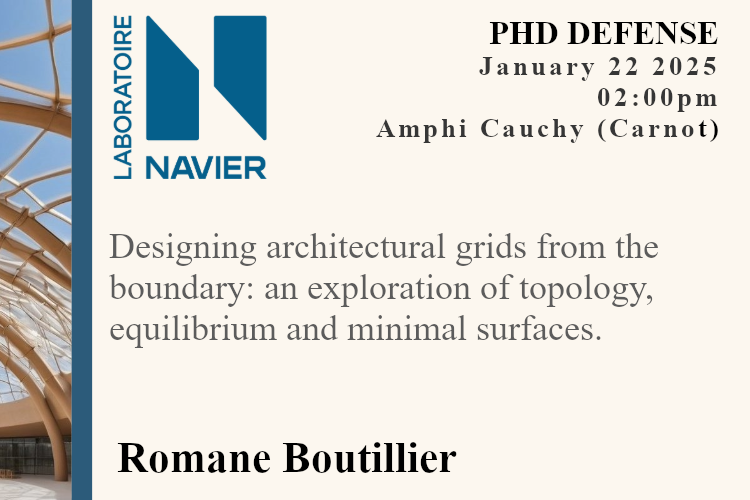
PhD Defense – Romane Boutillier
- Post by: sebastien.gervillers
- 17 January 2025
- No Comment
Romane Boutillier, a PhD candidate in the Architectured Materials and Structures team and LAMA will defend her dissertation titled « Designing architectural grids from the boundary: an exploration of topology, equilibrium and minimal surfaces » on Wednesday, January 22, at 2:00 PM, in the Cauchy amphitheater.
Composition of the jury :
- Allan McRobie – Professor, University of Cambridge (Reviewer)
- Benoît Roman – Research Director, ESPCI Paris – PSL (Reviewer)
- Magdalena Rodriguez – Professor, Universidad de Granada (Examinator)
- Fiammetta Venuti – Senior Researcher, Politecnico di Torino (Examinator)
- Christopher Williams – Professor, Chalmers University of Technology (Examinator)
-
Olivier Baverel – Professor, École Nationale des Ponts et Chaussées (Thesis Director)
-
Laurent Hauswirth – Professor, Université Gustave Eiffel (Thesis Co-Director)
- Cyril Douthe – Researcher, Engineer, École Nationale des Ponts et Chaussées (Thesis Supervisor)
The defense will be broadcasted live
Abstract
This thesis proposes a boundary-focused approach to surface design, as the boundary provides essential constraints, offers a design space, and must not be overlooked for architectural, structural, and mechanical reasons. The objective of this thesis is to develop design methods for discretised surfaces made up of quadrilateral panels, where the topology, shape, and forces are controlled by boundary data, including height, support conditions, and reactions.
The first part focuses on the creation of a discretised surface, covering the generation of its planar grid, its lifting, and its construction. After a review of form-finding and topology methods, chapter 2 introduces a topology generation method. Based on boundary shape and support conditions, minimal surfaces are used as a tool to trace a network with three advantageous geometric and mechanical properties:
- – Lines converge at support points, optimising force direction.
- – Lines are perpendicular to edge beams outside of support points.
- – Network lines intersect at right angles within the grid, apart from a finite number of singular points.
The method, along with its implementation and treatment of various boundary types, is detailed. This “topology-finding” approach can be used prior to form-finding methods that generate shapes from a given planar grid.
In chapter 3, the generated topologies are assessed through two processes that consider varied constraints across different project types and stages. The first study addresses the preliminary stage, where a broad variety of grids is evaluated based on three geometric and mechanical criteria. The second study, which led to the construction of two pavilions, demonstrates how this method can be integrated into a design and construction process that considers significant fabrication constraints. The second part explores various alternative methods to those in the first part.
Chapter 4 returns to the use of minimal surfaces in architecture and proposes an alternative way of generating an analytical expression of the grids using the Weierstrass representation. The latter is implemented to construct symmetrical compact Scherk surfaces from their edge, together with the gradient and level set network.
Chapter 5 develops a form-finding method to create a quasi-funicular structure with planar panels from a planar grid. This method is inspired by research linking the existence of self-stressed states with planar-faced polyhedra whose projections match the grid to be raised, and by methods involving the Airy stress function. It proposes to control reactions and heights at the grid’s boundary to approximate a near-funicular structure while ensuring panel planarity. It also introduces the concept of ”funicularity defect” to identify and locate the part of the load that gives rise to bending forces and thus provides a valuable tool for the design of structures.
Finally, chapter 6 opens the discussion to other types of boundaries and therefore other types of networks on minimal surfaces to ensure alignment. The focus is on edges supported only at their ends and loaded axially, which are asymptotic lines on minimal surfaces. The architectural use of minimal surfaces, particularly with this boundary type, is examined. Mathematically, the variational problem does not generally permit the construction of such surfaces as boundary geometry is unknown. The chapter concludes with a method for constructing minimal catenoids bounded by asymptotic lines through conjugation.
Keywords: Topology, form-finding, gridshell, minimal surface, funicular, thread problem.


